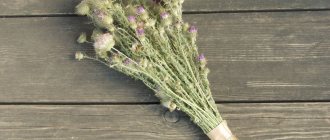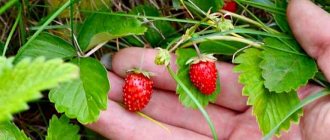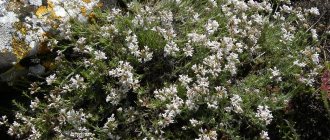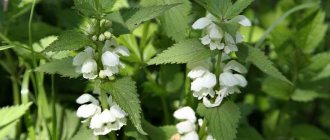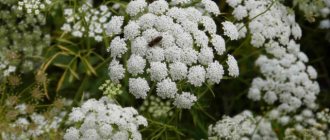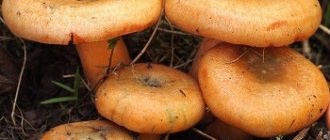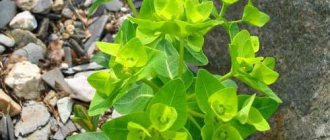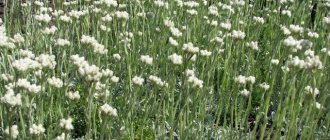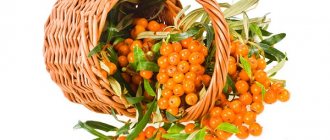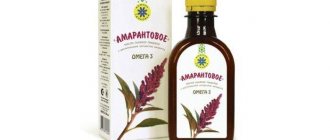How is Myrtle useful?
This plant can replace an entire pharmacy . When rubbed, the leaves emit a very strong odor that resembles the aroma of a coniferous tree. This smells like myrtle essential oil contained in the leaves of the plant. In addition to these oils, myrtle contains flavonoids, camphor, polyphenols, saponins and other substances.
has been used in folk medicine for a long time Tinctures, lotions, and decoctions are made from it.
Important: It is useful for the prevention and treatment of colds by simply chewing fresh myrtle leaves. Antimicrobial properties will help kill pathogens.
Myrtle in an apartment perfectly improves the health of the air. The leaves secrete phytoncides - substances that have bactericidal properties and destroy pathogenic microbes.
Surprisingly, a small tree can destroy up to 20% of streptococci and 40% of staphylococci.
The chemical composition of this amazing plant includes more than ten useful substances that have a beneficial effect on the human body.
Side effects and contraindications
A huge advantage of myrtle tree products is that they have no contraindications. If you follow the dosage and preparation recipe correctly, then no side effects will occur.
However, pregnant and lactating women should not use such products. In addition, some, when using myrtle products, noted the occurrence of headaches as a reaction to the tart smell of myrtle. Some people may have an individual intolerance to remedies from this plant, but this is not common. Therefore, there is no need to openly store tinctures, decoctions, dried leaves and myrtle berries. It is best to place them in airtight glass jars or bottles. Despite its many beneficial and medicinal effects, you should not consume myrtle in any form without consulting your doctor.
The myrtle tree is not only an ornamental plant, but also a raw material for the preparation of various medicinal products. Particularly popular is myrtle tincture, which has various medicinal properties. This and many other products based on the myrtle tree have therapeutic effects similar to antibiotic drugs, and some are superior to them.
Medicinal properties or treatment of myrtle
- strengthens the immune system;
- helps in the treatment of colds;
- used for diseases of the upper respiratory tract;
- has a wound healing effect;
- is a natural antiseptic;
- has an analgesic effect;
- successfully fights various tumors;
- excellent antiallergic agent.
And this is not the entire list of beneficial properties of this plant.
Myrtle oil is also successfully used in cosmetology.
Cosmetics using this oil moisturize and nourish the epidermis, treat problematic skin with acne. This essential oil also strengthens hair and improves hair structure.
- For skin diseases, lotions made from myrtle decoction are successfully used;
- If you have a sore throat, rinsing with this decoction will bring noticeable relief and a quick positive effect. Such rinses will be especially helpful for children;
- Myrtle infusion will help in the treatment of herpes. To do this, apply a cotton pad moistened with infusion to the affected area;
- For eye diseases, apply lotions from myrtle infusion directly to the eyes, and also take the healing tincture internally;
- An alcohol tincture with myrtle will help with purulent otitis media, bronchitis, pneumonia, etc.;
- 5 drops of myrtle oil dissolved in hot water is an excellent remedy for inhalation for colds;
- Rubbing myrtle oil into the gums will help with periodontal disease;
- Myrtle oil is a good rubbing remedy for various colds.
Polyextract Myrtle with Black Walnut from Nikitsky Garden
© NPP "NIKITSKAYA LABORATORY", 2015. INN 9103080075, OGRN 1169102069180. LEGAL ADDRESS: 298648, REPUBLIC OF CRIMEA, YALTA, PGT NIKITA, State Nikitsky Botanical Garden GNBS, no. 6. MTS/VIB ER
THE TRADE MARK “NIKITSKAYA LABORATORY” BELONGES TO THE NPP “NIKITSKAYA LABORATORY”, ALL OTHER TRADEMARKS AND MARKS BELONG TO THEIR RESPECTIVE OWNERS. THE QUALITY MANAGEMENT SYSTEM OF NIKITSK LABORATORY HAS BEEN CERTIFIED AND MEETS THE REQUIREMENTS OF GOST R ISO 22000-2007 HACCP, GOST R ISO 9001-2015, GOST R ISO 14001-2015 ECO, GOST R 54934-2012 (OHSAS 18001:2007). POLYEXTRACT OF GINKGO-BILOBA AND MEADOWLAGE, CONCENTRATE OF SOFT BEVERAGE “GINKGO-LAB”, POLYEXTRACT OF ECHINACEA PURPLE AND MYRTLE “ECHINOMAX-M”, AS WELL AS POLYEXTRACT OF MYRTLE AND BLACK WALNUT “MYRT-O”, EQUALLY LIKE THE OTHER PRODUCTS PRESENTED, THEY ARE MANUFACTURED IN ACCORDANCE WITH TECHNICAL REGULATIONS OF THE CUSTOMS UNION OF THE EAEU: TR CU 021/2011, TR CU 022/2011, TR CU 029/2012, ACCORDING TO TU 9185-601-88820521-15 OR GOST R 34144, FORM LENA PROPERLY ACCORDING TO THE CURRENT REGULATIONS OF THE CUSTOMS UNION, LEGISLATION OF THE RUSSIAN FEDERATION AND THE REPUBLIC OF CRIMEA. DECLARATION OF CONFORMITY "GINKGO-LAB" TS N RU D-RU.AYA83.V.01361. DECLARATION OF CONFORMITY "MIRT-O" EAEU N RU D-RU.AYA83.V.00200/19, VOLUNTARY CERTIFICATE OF CONFORMITY GOST R ROSS RU.AYA83.N02215. DECLARATION ABOUT "ECHINOMAX-M" EAEU N RU D-RU.AYA83.V.00556/19, VOLUNTARY CERTIFICATE OF CONFORMITY GOST R ROSS RU.AYA83.H02254. PROTOCOLS OF VOLUNTARY TESTS OF ROSPOTREBNADZOR No. 4806 AND No. 4807. BY DOWNLOADING INFORMATION FROM THE SITE nikita-store.RU OR IN ANY OTHER WAY USING THIS INTERNET SITE, REGARDLESS OF THE PURPOSE AND TECHNICAL MEANS, YOU AGREE TO THE PUBLIC TERMS OF ITS USE, PROCESSING POLICY PERSONAL DATA AND USER AGREEMENT. BY MAKING A PURCHASE USING A SPECIAL ORDER FORM, THIS MEANS THAT YOU HAVE READ THE TERMS OF PURCHASE, DELIVERY AND AGREE TO THE PUBLIC OFFER AGREEMENT. THIS INTERNET PAGE LISTS THE POTENTIAL PROPERTIES OF THE COMPONENTS OF THE ABOVE PRODUCTS. The proven effectiveness of the components is indicated in studies included in the National Library of Medicine of the US National Institutes of Health. ANY MENTION IN THE TEXT OF GEOGRAPHICAL NAMES, NAMES AND TRADEMARKS IS NOT AN INFRINGEMENT ON THEM, ALL INFORMATION PLACED HERE MUST BE TAKEN LITERALLY “AS IS” WITHOUT ANY INTERPRETATION. THE ADMINISTRATION IS NOT RESPONSIBLE FOR MATERIALS POSTED BY USERS, INCLUDING AUTOMATICALLY POSTED MATERIALS FROM THIRD PARTY RESOURCES (REVIEWS, NOTES AND COMMENTS). Feedback from customers who have used the PRODUCTS OFFERED BY US, AS WELL AS ANY RESEARCH OR PUBLISHED ARTICLES, INCLUDING THIRD-PARTY RESOURCES, do not constitute a recommendation for choosing the PRESENTED product. BY USING MATERIALS OF THIRD PARTY RESOURCES TECHNICALLY INTEGRATED ON THIS SITE, YOU AGREE TO THE USER AGREEMENT OF THE CORRESPONDING RESOURCES. Data for comparison of Ginkgo Lab, AS WELL AS OTHER PRODUCTS with functional analogues, are collected from open sources and are current as of May 1, 2016, UNLESS OTHERWISE STATED. THIS INTERNET SITE DOES NOT PROVIDE THE SERVICES OF HERBALISTS AND TRADITIONAL HEALERS, MEDICAL SERVICES, MEDICAL OR EMERGENCY CARE AND DOES NOT CONDUCT ADVISORY MEDICAL OR PHARMACOLOGICAL SUPPORT, INCLUDING REMOTE WAYS OM. THE DEGREES MASTER OF MEDICINE IN ALTERNATIVE MEDICINE AND DOCTOR OF MEDICINE IN NATURAL MEDICINE (DOCTOR OF NATUROPATHY) ARE RECOGNIZED IN THE USA, CANADA, AUSTRALIA, NEW ZEALAND AND A NUMBER OF EUROPEAN STATES, DEGREE OF DOCTOR OF MEDICINE IN NATURAL MEDIC INE (DOCTOR OF NATUROPATHY) IS NOT EQUIVALENT DEGREES OF DOCTOR OF MEDICAL SCIENCES, DUE TO THE LACK OF EQUAL SPECIALTIES IN THE ALL-RUSSIAN CLASSIFICATION OF PROFESSIONS, THESE DEGREES ARE NOT ACADEMICALLY RECOGNIZED IN THE TERRITORY OF THE RUSSIAN FEDERATION. SOME COMPONENTS OF THE PRODUCTS PRESENTED MAY HAVE INDIVIDUAL LIMITATIONS FOR USE, PLEASE CONSULT WITH A PROFESSIONAL BEFORE USE. DUE TO THE FACT THAT THE ENTERPRISE IS LOCATED IN THE TERRITORY OF THE REPUBLIC OF CRIMEA, THE TERMINOLOGY ACCEPTED IN THE CRIMEA IS USED ON THE SITE. THIS SITE IS INTENDED FOR ADULT CITIZENS AND RESIDENTS OF THE RUSSIAN FEDERATION. THE PUBLIC OFFER AGREEMENT EXTENDS EFFECT ONLY TO RESIDENTS OF THE RUSSIAN FEDERATION. THE INFORMATION IS 18+ CONTENT
Diseases and pests
In unfavorable conditions and with careless care, the plant can be affected by diseases and pests, as evidenced by a change in the appearance of the tree:
- the roots rot - when the root collar is deepened during transplantation (resuscitation is useless);
- myrtle leaves turn pale and the stems lengthen – there is a lack of light (move to a brighter place); leaves fade from direct sunlight (shade the plant);
- the base of the stem rots - deepening of the root collar during transplantation (the plant cannot be saved);
- the edges of the leaves curl - in direct sunlight (shade);
- rapid falling of leaves in winter - keeping it warm in an unlit place, waterlogging the soil (move to a cool, bright place, adjust watering);
- leaves fall off - little light, improper watering, dry air (move to a brighter place, spray more often, adjust watering);
- leaves turn yellow – nutrient deficiency (feed).
Most often other pests are affected by scale insects, mealybugs, and spider mites. Insecticides are used against them.
Common myrtle plant - what is it?
This plant is an evergreen and woody shrub or low-growing tree. It can be grown not only outdoors, but also at home. Myrtle is a fragrant plant that has opposite, leathery, dark green leaves with a polished surface.
Its flowers are single or numerous, collected in short racemes. The essential oil contained in the plant is used in aromatherapy, perfumery and medicine. In ancient times, a myrtle wreath was one of the main decorations of the bride.
Contraindications for use, negative effects
For eye diseases of an inflammatory nature, it is recommended to use an infusion for instillation. You can prepare it as follows: 5 leaves of myrtle must be rubbed with your hands. After this, they are poured with a tablespoon of boiling water and then cooled. 2 drops should be instilled into each affected eye. In parallel with this, you can take myrtle tincture orally. This complex will help stop the loss of visual function.
For the treatment of diseases of an infectious-inflammatory nature, it is recommended to take up to 30 drops of tincture three times a day. Application should be carried out half an hour before meals. If the drug is well tolerated, the single dose can be increased to a teaspoon. It is allowed to mix the tincture with tea leaves or rosehip decoction.
When treating cancer, it is recommended to use myrtle leaf powder as a seasoning for food for up to 15 months. The recommended amount is a teaspoon of powder. After three months, the course must be repeated. When using myrtle tincture for cancer therapy, it is recommended to take up to 4 teaspoons up to 5 times a day.
It is not recommended for pregnant women and women during the lactation period to take myrtle preparations. In some cases, users note that headaches may occur while using myrtle tincture. In rare cases, patients experience individual hypersensitivity to myrtle-based products.
Antiviral properties
Research shows that myrtle has antiviral properties, particularly against the herpes simplex virus. Under the influence of the drug, the proliferation phase of the virus is inhibited, and the occurrence of new damage caused by the vital activity and reproduction of the virus is prevented. The greatest effectiveness of myrtle preparations is observed during the first hours of infection with the virus.
This means that therapy for a patient infected with the virus must begin before destructive changes in cells occur. In this case, a herpetic pustule and a scar on the skin do not form. For this purpose, the ointment preparation “Mirtoplex” was developed. The ointment is a ten percent essence of the myrtle tree, intended for topical use.
As is known, viruses that provoke herpes on the skin are similar in structure to cytomegalovirus, which can be found in the cellular structures of the brain of the head. In this regard, it can be assumed that the use of certain dosages of myrtle tincture orally can eliminate this problem. However, full-fledged studies have not been conducted in this regard. In addition, some scientists suggest that cancer is also viral in nature.
It is likely that the proven preventive effect of myrtle against cancer pathologies is associated with the antiviral properties of the plant. Probably, obtaining a therapeutic effect in oncological pathologies can be achieved by using many times increased prophylactic doses of myrtle. That is, there is a possibility that a single dose of up to 50 grams of myrtle tincture can be effective in cancer therapy.
Benefits of myrtle essential oil
Essential oil is obtained not from wood, but from shoots along with leaves, which are crushed and then steam distilled. The myrtle herb is used to produce a thin, slightly orange oil.
The aroma of the ether is slightly bitter, similar to eucalyptus and cypress. It is worth noting that myrtle oil goes well with other oils and has many beneficial properties:
- It affects the activity of the nervous system, helping to calm down in a stressful situation, cope with fatigue, depression and insomnia. Common myrtle is an active aphrodisiac.
- It is an effective antiseptic and quickly deals with bacteria, so the action of myrtle is compared to medical antibiotics.
- It copes well with respiratory tract infections, so it can be used for inhalation.
- For massages, oil is added to the cream, taking into account that there should be 4-6 drops per 15 g.
The fragrant and surprisingly calming myrtle - a symbol of glory, love unions, good deeds - was a sacred plant and very revered even before the era of Hellenistic culture, although the ancient Greeks glorified this plant and the oil extracted from its leaves.
It was they who first began to actively use myrtle oil for incense and associated the smell of this tree with impeccably glossy foliage and beautiful flowering with mythological legends.
In antiquity, myrtle was a symbol of the goddess Venus, and the very origin of the plant was associated with the sad legend of a beautiful nymph who died at the hands of the treacherous Athena, in whose honor the beautiful representatives of the trees were named.
During the Renaissance, myrtle was the main symbol of marital fidelity and eternal union; in Christian culture it was perceived as a symbol of hope, and in Arab culture it was perceived as a symbol of the Garden of Eden. Even the royal traditions of Britain are invariably associated with this plant, which is used in royal weddings.

